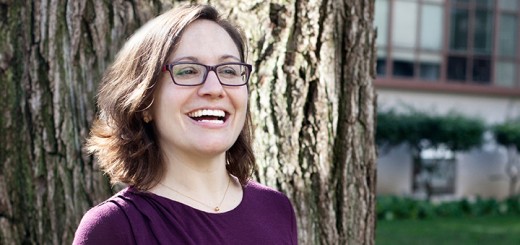Editor’s Perspective: Finders, Keepers

Photo: David Schmitz
Leaning into cold gusts hurtling off the ocean, I walked toward the flashing light of the three-ton lens atop Point Cabrillo Light Station. For most of the last century, lighthouse keepers made lives of standing watch over this piece of the Mendocino Coast, ensuring safe passage for ships along the rocky shoreline.
My husband and I were on vacation, both of us looking for respite from our high-speed lives in the crashing waves of the Pacific. I was looking to escape busyness by imagining an introvert-friendly career as a lighthouse keeper. We stepped inside the lighthouse, beneath its crimson rooftop, to explore an exhibit about lighthouse keepers’ noble—and often-solitary work.
Unexpectedly, we also found a reminder of San Jose State: a series of displays showcasing the 1984 “surprise discovery” of now-retired SJSU Professor Emeritus of Anthropology Thomas Layton and his students. “Hey, we know Tom! San Jose State’s people really are everywhere,” I said, pleased to discover a familiar face from campus and the work of fellow Spartans. I had no idea that this was just the beginning of the story.
“San Jose State’s people really are everywhere.”
Before the lighthouse was established in 1909, Frolic Cove, just to the north of Point Cabrillo, was the site of the 1850 wreck of the clipper brig Frolic, “the most significant shipwreck on the west coast,” according to historians at the San Francisco Maritime Museum. Layton and his students unearthed pieces of glass and blue and white pottery from the wreckage while following the trail of the Mitom Pomo people.
As it turns out, Washington Square wrote about the discovery in 1994. Layton has also published two books on his research, which has been highlighted in newspapers and beautifully captured in Impact of the Frolic, a documentary now shown on PBS that won a Northern California-area Emmy Award in 2014-15. The local significance of the Frolic’s wreck was that the 1851 salvage attempt led to the discovery of the redwood forest—which led to the creation of towns and mills along the Northern California coast. Layton explains the magnitude of his findings in the documentary:
“It revealed a world system linking Boston merchants, Baltimore ship builders, opium producers in Bombay, smugglers on the coast of China to entrepreneurs in Gold Rush San Francisco and the Mitom Pomo.”
There’s even a connection to abolitionist Frederick Douglass. Thanks to Layton’s expert sleuthing, San Jose State can claim a place in that history, too.
Be part of the adventure. Watch Impact of the Frolic to follow Layton’s quest to solve the mystery he unearthed.



